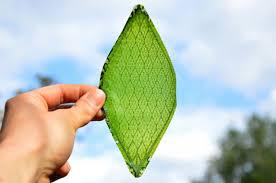
Thanks to the development of a graduate from the “Royal College of Art” now oxygen can be available in space. Julian Melchiorri supposed to have designed the “silk leaf” that is capable of creating oxygen, which can add back to the heavily polluted earth the much needed wisp of oxygen besides generating oxygen “for space travel”. The development took place in collaboration with “a silk lab from Tufts University”.
A matrix was created by extracting proteins from chloroplasts and silk which shaped the leaf. Chloroplasts, the green pigment of the flora is responsible for the algae and plants to carry on the process of photosynthesis. When light falls on the leaf and water is provided to silk synthetic leaf, it begins to function like a “real leaf” and begins the production of oxygen. Melchiorri explains:
“It’s very light, low energy-consuming. It’s completely biological and my idea was to use the efficiency of nature in a man-made environment. I created some lighting out of this material, using the light to illuminate the house but at the same time to create oxygen for us.”
However, Malchiorri’s dream of silk leaf producing oxygen gives him wings to shatter the boundaries of houses and fly to the star trodden path of spaces. Consequently, he dreams bigger than a “small fixtures” for the artificial leaves. Therefore he informs:
"NASA is researching different ways to produce oxygen for long-distance space journeys to let us live in space. This material could allow us to explore space much further than we can now."
When about the Martian-human settlements, these leaves can play a crucial role, as they can be fitted onto “the facades of buildings and inside ventilation systems” whereby they can produce fresh oxygen. Moreover, astronauts can also avail of their use in their spatial missions. Although, the whole things sounds quite fascinating and mirrors the process of Photosysthesis, in reality, it differs from the ways of nature. The way these silk leaves work has been summarised within an equation given below:
6CO2 + 6H2O + --(Sunlight Energy)--> C6H12O6 + 6O2
When one simple talks about photosynthesis, there are various components that needs to be take into consideration as the process of photosynthesis is performed by plants in order to break down the sugar and to “create food for themselves”. In the case of Silk Leaf, the carbon dioxide, light, oxygen, and water can be accounted for but the missing links are the presence of sugar. In fact:
“There isn’t an explanation as to what happens to the carbon and hydrogen that the leaf takes in. Silk Leaf lacks the vacuoles, stems, and roots that store food in plants”.
Although, researches conducted by ISS have shown plants can be grown in the space, yet it requires a considerable amount of “soil, water, and plants” in order to provide sufficient oxygen for an astronaut to breathe, therefore these Silk Leaves which are “a lightweight alternative” can prove “beneficial”.
References:
http://www.iflscience.com
A matrix was created by extracting proteins from chloroplasts and silk which shaped the leaf. Chloroplasts, the green pigment of the flora is responsible for the algae and plants to carry on the process of photosynthesis. When light falls on the leaf and water is provided to silk synthetic leaf, it begins to function like a “real leaf” and begins the production of oxygen. Melchiorri explains:
“It’s very light, low energy-consuming. It’s completely biological and my idea was to use the efficiency of nature in a man-made environment. I created some lighting out of this material, using the light to illuminate the house but at the same time to create oxygen for us.”
However, Malchiorri’s dream of silk leaf producing oxygen gives him wings to shatter the boundaries of houses and fly to the star trodden path of spaces. Consequently, he dreams bigger than a “small fixtures” for the artificial leaves. Therefore he informs:
"NASA is researching different ways to produce oxygen for long-distance space journeys to let us live in space. This material could allow us to explore space much further than we can now."
When about the Martian-human settlements, these leaves can play a crucial role, as they can be fitted onto “the facades of buildings and inside ventilation systems” whereby they can produce fresh oxygen. Moreover, astronauts can also avail of their use in their spatial missions. Although, the whole things sounds quite fascinating and mirrors the process of Photosysthesis, in reality, it differs from the ways of nature. The way these silk leaves work has been summarised within an equation given below:
6CO2 + 6H2O + --(Sunlight Energy)--> C6H12O6 + 6O2
When one simple talks about photosynthesis, there are various components that needs to be take into consideration as the process of photosynthesis is performed by plants in order to break down the sugar and to “create food for themselves”. In the case of Silk Leaf, the carbon dioxide, light, oxygen, and water can be accounted for but the missing links are the presence of sugar. In fact:
“There isn’t an explanation as to what happens to the carbon and hydrogen that the leaf takes in. Silk Leaf lacks the vacuoles, stems, and roots that store food in plants”.
Although, researches conducted by ISS have shown plants can be grown in the space, yet it requires a considerable amount of “soil, water, and plants” in order to provide sufficient oxygen for an astronaut to breathe, therefore these Silk Leaves which are “a lightweight alternative” can prove “beneficial”.
References:
http://www.iflscience.com





